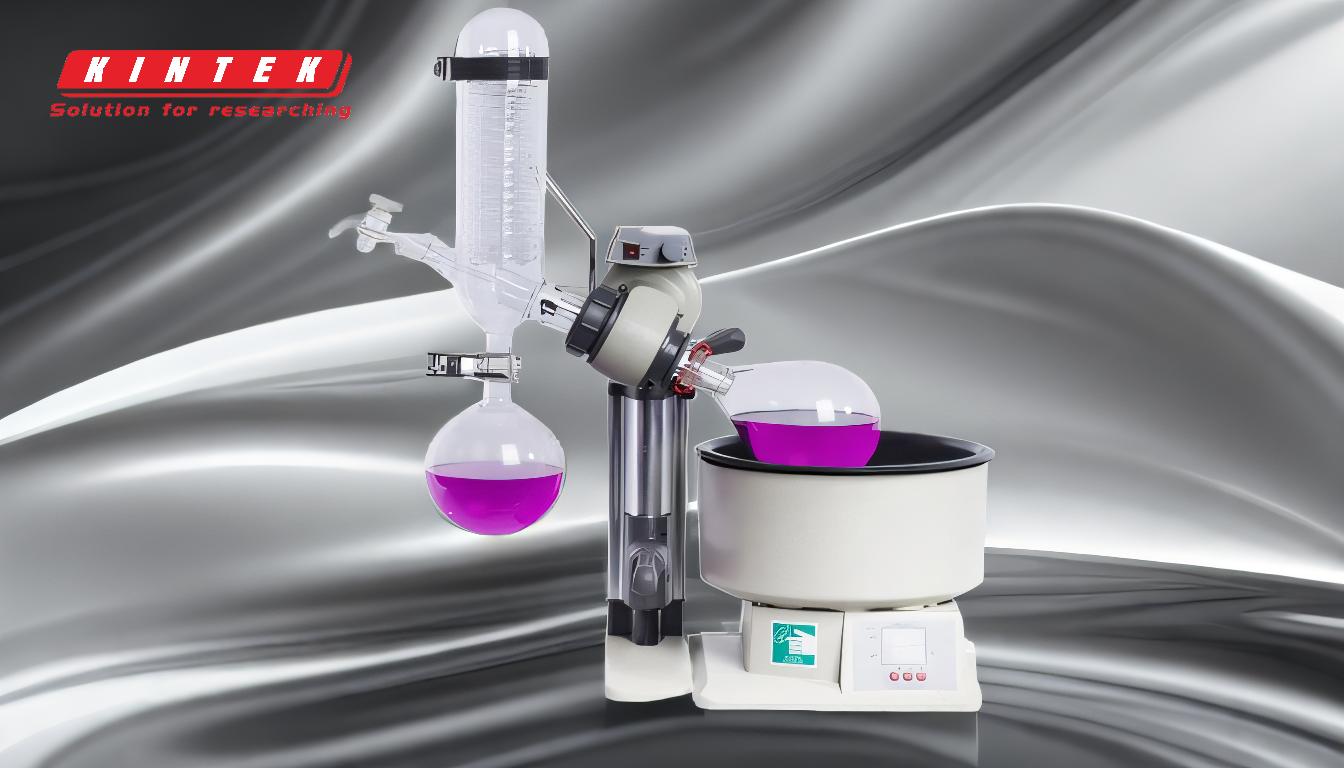A rotary flash evaporator operates by combining reduced pressure (vacuum), controlled heating, and rotational motion to efficiently evaporate solvents or separate components from mixtures. The process begins by placing the liquid sample in a rotating flask, which is heated indirectly via a water or oil bath. The flask rotates at a constant speed, creating a thin film of the liquid on its inner walls. This increases the surface area for evaporation and ensures uniform heat distribution. Under reduced pressure, the boiling point of the solvent decreases, allowing evaporation at lower temperatures, which is particularly useful for heat-sensitive materials. The vaporized solvent travels through a vapor tube, condenses in a cooled condenser, and is collected in a separate flask. This process is widely used in chemical, pharmaceutical, and research settings for solvent recovery, concentration, and purification.
Key Points Explained:

-
Reduced Pressure (Vacuum) Principle:
- The rotary flash evaporator operates under high vacuum conditions, typically around 1 torr.
- Reducing the pressure lowers the boiling point of the solvent, enabling evaporation at lower temperatures.
- This is crucial for heat-sensitive materials, as it minimizes thermal degradation or property alteration.
- Example: Dimethylformamide (DMF) and dimethyl sulfoxide (DMSO) can boil at 50°C under 5 torr, compared to their much higher boiling points at atmospheric pressure.
-
Rotational Motion:
- The rotary flask rotates at a constant speed, creating a thin film of the liquid on the inner walls of the flask.
- This thin film increases the surface area for evaporation, significantly speeding up the process.
- Rotation also ensures uniform heating, reducing the risk of localized overheating or "bumping" (sudden, violent boiling).
- The rotational mechanism is particularly beneficial for volatile and heat-sensitive materials, as it promotes even mixing and prevents prolonged exposure to direct heat.
-
Indirect Heating:
- The flask is heated indirectly via a water bath or oil bath, which provides controlled and uniform heating.
- Indirect heating prevents direct contact between the heat source and the sample, reducing the risk of thermal degradation.
- The temperature of the bath is carefully regulated to match the reduced boiling point of the solvent under vacuum conditions.
-
Evaporation and Condensation:
- As the liquid evaporates, the vapor travels through a vapor tube to the condenser.
- The condenser is cooled, typically using a circulating coolant, to condense the vapor back into a liquid.
- The condensed liquid is collected in a separate receiver flask, allowing for solvent recovery or separation of components.
-
Applications:
- Rotary flash evaporators are widely used in chemical, pharmaceutical, and research laboratories.
- Common applications include solvent recovery, concentration of solutions, purification of compounds, and drying of samples.
- They are particularly useful for processing heat-sensitive materials and high-boiling-point solvents.
-
Advantages:
- Efficient evaporation due to increased surface area and reduced boiling points.
- Gentle processing of heat-sensitive materials, minimizing degradation.
- Versatility in handling a wide range of solvents and mixtures.
- Automation and ease of use, with features like lifting mechanisms for efficient setup and operation.
-
Lifting Mechanism:
- Some rotary evaporators are equipped with an electrical-touched mechanical switch for lifting the flask.
- This mechanism allows for fast lifting with liquid-pressed assistance and steady-speed lowering, saving time and labor while increasing operational efficiency.
By combining these principles, the rotary flash evaporator provides a highly efficient and controlled method for solvent evaporation and separation, making it an indispensable tool in various industrial and research settings.
Summary Table:
| Key Feature | Description |
|---|---|
| Reduced Pressure | Operates under high vacuum (1 torr), lowering solvent boiling points. |
| Rotational Motion | Creates a thin liquid film for faster evaporation and uniform heating. |
| Indirect Heating | Uses water or oil baths for controlled, uniform heating to prevent degradation. |
| Evaporation & Condensation | Vapor condenses in a cooled condenser and is collected in a separate flask. |
| Applications | Solvent recovery, concentration, purification, and drying of heat-sensitive materials. |
| Advantages | Efficient, gentle, versatile, and easy to operate with automation features. |
Discover how a rotary flash evaporator can optimize your lab processes—contact us today for expert advice!












